
© Paul Kolnik. (Click image for larger version)
New York City Ballet
New Combinations: The Most Incredible Thing, Polaris, The Blue of the Distance, Common Ground, Estancia
★★★✰✰
New York, David H. Koch Theater
2 February 2016
www.nycballet.com
In these days of 24/7 media, it’s easy for even deserving things to be overhyped. No doubt if Diaghilev – who was no stranger to publicity in his day – was alive today he would still give a limb for the amount of visibility, publicity and budget Justin Peck has had for his latest work, The Most Incredible Thing.
No expense has been spared in promoting Peck’s one-act work, which is based on the eponymous Hans Christian Andersen tale. There is a lavish trailer, has been ample advance press, a special all-black hard stock sleeve enveloping the Playbill and a long list of funding contributions within it. It all worked: the Koch Theater was heaving Tuesday night with a crush as big as that for any red carpet gala, but was the hype worth it?
Incredible Thing is hipster overload in terms of collaboration: Peck, still under 30 and a critic’s darling, choreographed it; David Zwirner-represented artist Marcel Dzama designed the sets and costumes; Bryce Dessner of indie rock band The National composed the commissioned score. While not of the same stature, in concept this triumvirate harkens back to Diaghilev’s commissions for the Ballet Russes and its cross-disciplinary collaborations with Stravinsky, Picasso, Matisse, etc. The combination of these three and their corralled potential (and popularity) proved too much for anyone to resist: everyone who was anyone on the dance scene in the tri-state area was warming a seat at the Koch Tuesday night.
A sellout show and high expectations is as much to do with Peck as any other variable. Hugely popular with press and populus right out of the gate, this is his 10th work for NYCB, and with the nine previous dances he has garnered himself a loyal following and set his own bar rather high.
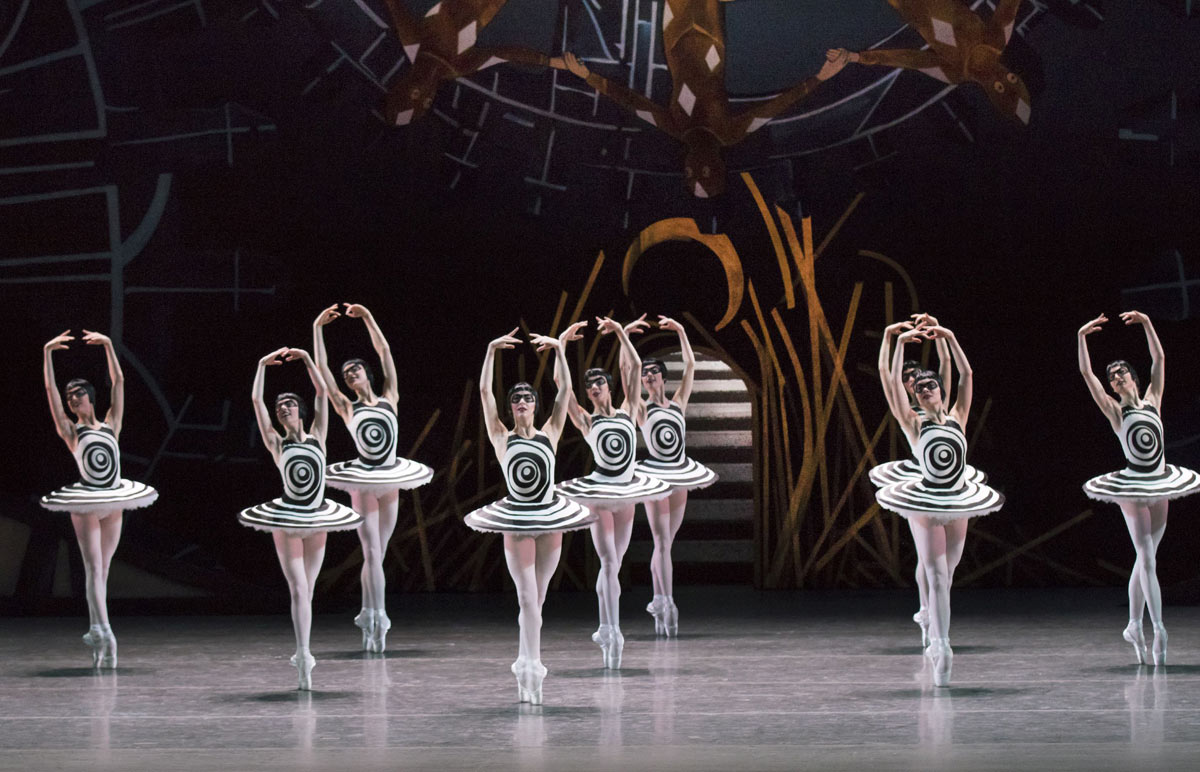
© Paul Kolnik. (Click image for larger version)
Incredible is Peck’s first narrative, and this fact was obvious Tuesday night, particularly in the opening scenes which lacked clarity in the mime. For anyone unfamiliar with the story, a King (Russell Janzen and Ask la Cour – donning armor and looking as if they are about to run the three-legged race) declares there will be a contest for his daughter’s hand in marriage: anyone who can do the most incredible thing can marry the Princess (Sterling Hyltin). A young man, known as The Creator (Taylor Stanley) has made an incredible clock, with living, moving parts. As he describes his invention, the Princess takes to him. The King demands a demonstration, and the clock figures – a different thematic group at every hour – dance. Then the Destroyer (Amar Ramasar) shows up, tears the clock to pieces and sways everyone to believe in his conquering he has done the most incredible thing. On the brink of taking the Princess’ hand, the Destroyer is taken down by a mutiny of clock figures, and the Creator and Princess wed, dance for joy, etc.
It’s easy to see why Peck would choose this for what might seem like a simple story ballet, the twelve performance segments are built in, and are already thematically grouped by Andersen, all Peck and Dzama would have to do is illustrate them, and here again there are hits and misses. The Eight Monks at Eight O’Clock were obvious, clearly communicated by their druid-like costumes, candles and secretive clusterings. The Nine Muses, clad in swirling op-art tutus of deep iridescent green and white, shellacked Louise Brooks bobs and Dzama’s trademark bandit masks, performed all of a kind – they had some of the best choreography but were a corps of nine rather than representing the individual arts. Ditto with the Five Senses, which were dressed in large, silver, tiered triangular hooped dresses with cone turtlenecks (think of a domestic pet cone).

© Paul Kolnik. (Click image for larger version)
Tiler Peck – emerging from a mini bower bird nest – twittered on fleet feet as the Cuckoo Bird, which introduces the action at One O’Clock and returns at 10. Her footwork is difficult, but perhaps needn’t appear to be. Many steps look half-finished, Peck turning this way and that before her limbs strike any recognizable position. No doubt this is as Mr. Peck intended: something less Petipa and more realistically fragmented, a skittish bird’s anxious activities. But the lack of more obviously completed footwork leaves something wanting. Daniel Ulbricht is dizzying as The Gambler (a die numbered six), swirling like a dervish to conversely quiet music. The Seven Deadly Sins, much like the Muses, dance as a corps, with nods to Nijinsky’s faun in the gestures. Ramasar is effective as The Destroyer, and peels away creepily, exiting the stage in a diagonal lean that turns into a run.
The finale ensemble choreography is the most complete of the whole ballet, filled with pendulous, weighted, swinging rhythms Peck does so well, but it ends abruptly and c’est fini. Incredible shares a filial spirit with Nutcracker (a wizard-like clock maker), Sleeping Beauty (birdlike fairies, etc.) and other story ballets with its divertissement. Maybe Peck was wary, and avoided replicating tropes (a tinkering inventor in his shop) on purpose – not a bad decision if there are comparable substitutes to communicate the story. In actuality, most people don’t go to story ballets for the story, they go for the breadth of dancing, and in this Peck also treads too lightly. Several divertissements had barely any dancing; was this costume driven – many of Dzama’s costumes are, for all their inventiveness, rather unwieldy – or just an oversight? The sets and costumes are dazzling but also overwhelming, quite unlike much of Dzama’s most popular work which is often small, delicate, almost dainty. While it’s exciting to see his wild creations brought to surreal size, it may not always be in the best interest of dance, movement and staging. Incredible is not incredible but it is whimsical, and with some tweaks could be a real winner some day.
Believe it or not, there were not just one, but four other works on the program Tuesday (an odd choice given that Incredible is nearly an hour), the best of which remains Troy Schumacher’s Common Ground, which premiered in New York last fall.
Amar Ramasar must adore this piece, because he positively overflows. His leaps are both sharp and boundless, and he beams throughout. In partnering Teresa Reichlen in an attitude promenade, Ramasar lowers himself and rotates her with his head in the small of her back – tender, affectionate, sexy; later he is flirtatious, hip swiveling and groovy, relishing the work’s mutifaceted moods. Ashley Laracey was bright, jubilant and speedy without being sloppy, and Anthony Huxley exhibited the crystalline technique and musicality that got him his principal dancer promotion last year.
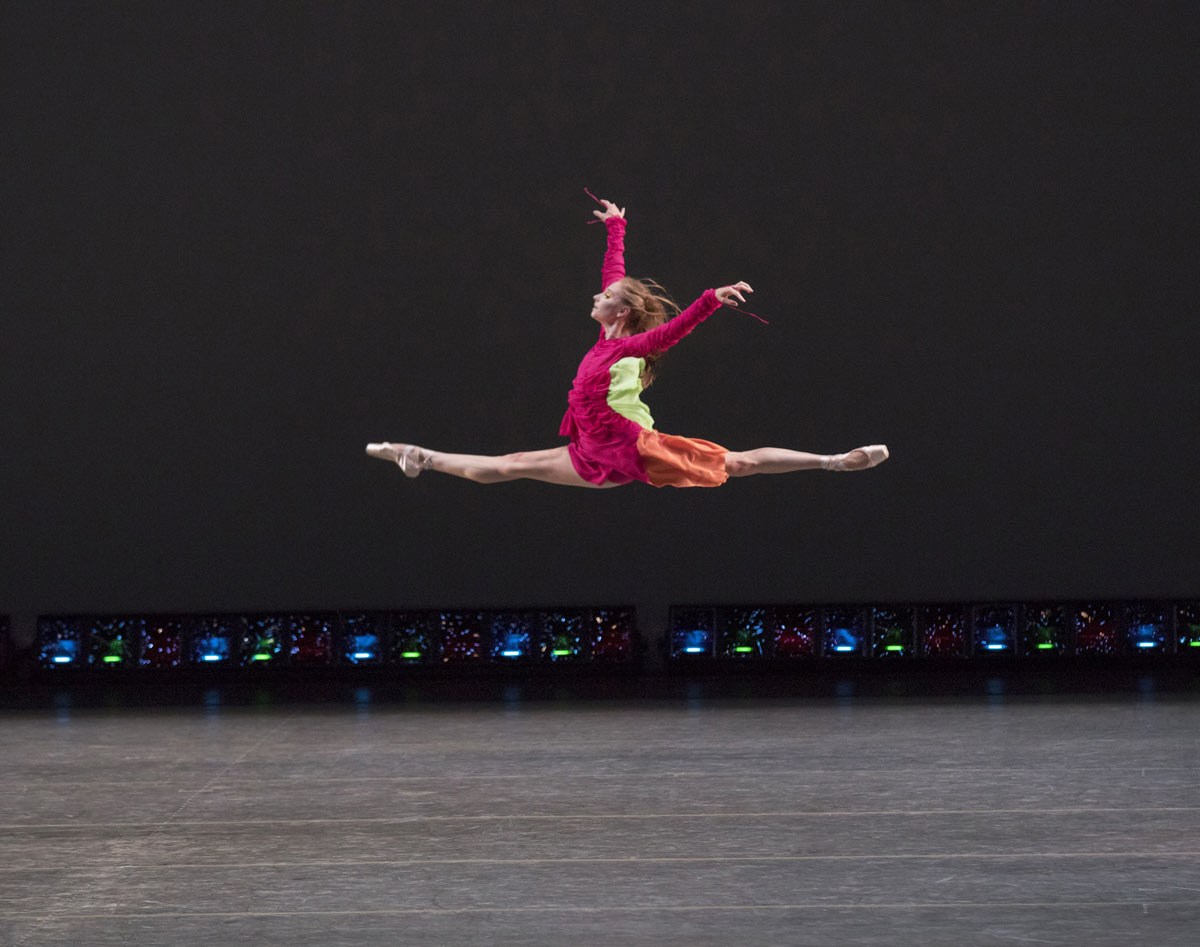
© Paul Kolnik. (Click image for larger version)
The brassy, bright, percussive score by Ellis Ludwig-Leone has that all-American sound NYCB dances to so well. Schumacher gives a spinal centrality to the movement, all dancers draw their bodies into and away from their spine along the same anatomical channel, a gentle corkscrew swivel up or down, while maintaining traditional balletic structure and symmetry. The primary criticism is the flappy, fluorescent, rayon-y costumes by Marta Marques and Paulo Almeida which distract from and ruin the line. Common Ground is playful, frequently flirtatious and choreographically confident, ending with the dancers collapsed on the floor like so many tuckered out specks of confetti.
Myles Thatcher’s Polaris suffers from overly bedazzled costumes by Zuhair Murad – they are pale denim blue, the men in high collar sleeveless vests – and some awkward lifts. The women – Emilie Gerrity and Ashly Isaacs – are very animated compared to the male dancers, but their inquisitive staring out into the audience (which one imagines, is supposed to be outer space given the cosmic backdrop and title), wears thin fast. Thatcher pivots from aqueous fluid movement to finding sudden three-dimensional, sculptural strength, but the contrast is not enough to carry home a meandering work. Robert Binet’s The Blue of Distance does not fare much better either. Hanako Maeda’s costumes – stark white classical tutus with dark blue bodices and Swarovski crystals – look like they belong on an ice skating rink. Danced to selections from Ravel’s “Miroirs” (“Oiseaux Triste” and “Une Barque sur L’Ocean”) and set on a dimly lit stage, The Blue of Distance is decidedly melancholic in tone, with many swan references in the port de bras for the women and some sensitive choreography for the men, which vacillates between catlike alertness and birdlike lightness.

© Paul Kolnik. (Click image for larger version)
Christopher Wheeldon’s Estancia – set Alberto Ginastera’s eponymous suite – was the real odd duck on the program even though, as another one-act narrative, it could have bookended well with Incredible. The storytelling here is clear, but the package doesn’t seem worth it. Tiler Peck played the energetic, autonomous country girl who can tame wild horses on the Argentine Pampas, partnered by Tyler Angle, the city boy who yearns for her. There are hands on hips, jaunty leans, runs and Rodeo-like posturing. Five dancers in horse costumes, including bits and frayed whips for tails, prance around until they are tamed in a sequence of belabored choreography (it is hard not to feel sorry for any dancer who has to don this costume, at any age). As Angle eventually subdues the lone wild stallion (Andrew Veyette), Peck watches his moves closely and there is an eerie, discomforting feeling that they are entering into a creepy sadist pact as they celebrate the horse’s struggle into submission. The feisty finale has all the snapping fingers and colored handkerchiefs one could want but many of the moves, if you’ve seen Wheeldon, you have seen before, and the vocabulary starts to look limited.












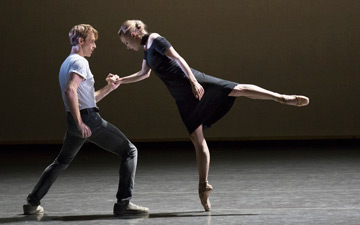
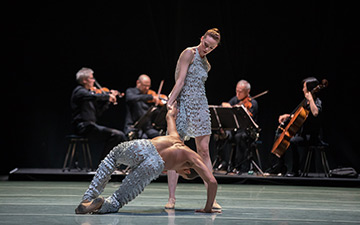

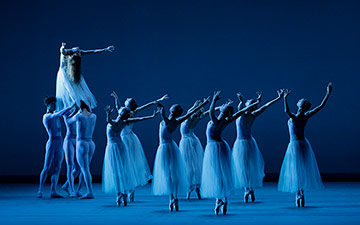

“Incredible” was completely costume-driven to the point where I could not even see the choreography. Such an expensive bellyflop for the NYCB. Time to re-stage it in leotards and without the scenery.